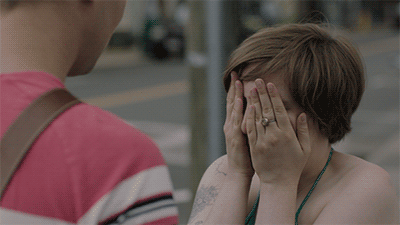The Self-Awareness of HBO's Girls

The characters on Girls are unlikable. Of the many charges laid against HBO’s deeply polarizing comedy series since it debuted in April 2012, that seems to be the most common. The show did little to dissuade viewers of this idea during its third season, which ended on Sunday: the four main characters continued to do idiotic and immature things with startling frequency this year. But the presence of unlikable characters is hardly a reason to dismiss the show.
There’s a strangely pervasive idea, borne either of scenes taken out of context or just of willful misunderstanding, that Girls endorses its characters’ behaviour and that the show’s creator and star Lena Dunham is simply playing herself. But Girls is a show that’s remarkably self-aware, that laughs and cringes along with the ridiculous but realistic pratfalls of its four very misguided protagonists.These characters may be horrifyingly selfish, but they are also deeply human in a way that’s incredibly refreshing and near-unprecedented.
There’s a lot of sex on Girls, but none of it serves the functions we’ve come to expect from sex on TV. It isn’t used to reinforce the bonds of true love, with flattering lighting and a camera that pans away tastefully. It isn’t used to titillate or to pander to male viewers (something that has been very, very hard for many of the show’s most vocal critics to understand). The sex depicted on the show is something entirely different, awkward and messy and devoid of the banal flourishes usually added to make it more palatable to a TV audience. Sometimes it’s satisfying, but often it’s not; sometimes it’s downright degrading. It involves bodies that don’t all look like they belong to professional models. In one memorable episode this season, the show’s main character Hannah goes to absurd lengths to entice her boyfriend Adam back into the bizarre and degrading sexual fantasies he used to love and she used to tolerate. We never saw Hannah derive any pleasure from these scenarios, but she’s still worried when they stop. She tries hard to please him, only to be told that she has an old idea of who he is. It’s really powerful to see a TV show even approach concepts of sexual compatibility, mutual pleasure and boundaries. The frankness and lucidity with which Girls handles these topics makes a welcome change from the vague scenarios and euphemistic language (or the crude, male-focused bacchanalia) that so often accompany sex on TV. Another startlingly realistic scenario involves Hannah’s friend Marnie, who begins a physical relationship with another friend’s ex-boyfriend, a person with whom she has nothing in common save for their mutual disdain for one another. Their illicit sexual encounters aren’t treated as exciting or scandalous or even very enjoyable; they’re simply two lonely people seeking validation from anyone willing to offer it. “I know I use sex for validation, because that’s what I do,” Marnie says in a moment of candour. It isn’t a salacious affair or some kind of moralistic teachable moment, it’s something that’s both kind of sad and completely understandable.
Girls is rarely credited for the depth and honesty with which it explores not only sexuality but platonic friendships. The majority of media aimed at women is overwhelmingly concerned with romantic plots, but Girls is just as concerned with the relationships between the main female characters. Hannah’s relationship with Marnie, for example, is just as chaotic and conflicted—and just as significant—as her relationship with Adam. We’ve seen them love and support and resent and hurt each other with as much poignancy as in the show’s romantic relationships. At Hannah’s birthday party, Marnie pulls her onstage to sing a duet from Rent they had sang together at another birthday years before, presumably when their friendship was less fraught. Hannah is reluctant and uncomfortable; Marnie is at once earnest in trying to revive an old friendship, selfish in her attempts at self-promotion for her singing career and desperate to project a happy and confident image in the face of her recent breakup. It’s a moment that encapsulates the many conflicting motivations these characters have: they’re massively self-interested but desperate to connect with other people; they’re obnoxiously eager to be praised but too insecure to ask for what they actually need; they’re constantly trying both too hard and not hard enough. In some ways this scene resembles Hannah’s attempts at role-play with Adam: we see people who are willing to go to dramatic, self-destructive lengths to remedy failing relationships, but in ways that are hopelessly and hilariously solipsistic.
Girls is not for everybody. It’s certainly true that it can sometimes be exhausting to not feel that there’s anyone to root for.The show’s lack of diversity is worth talking about as well, although it’s hardly the only show on TV to focus on the lives of privileged white people and the answer to the question of why it was subjected to more intensive scrutiny than male-focused media ever receives is obvious enough to go unsaid. But a TV show that’s willing to be brutally honest about these kinds of experience is really valuable—not to all women, but certainly to some. In the recent season finale, Hannah says she wants to “find a hole in the world, in the shape of me, and just fill it up.” In a “golden age” of television that celebrates morally compromised suburban men leading double lives, surely there’s also a place for selfish and confused women to continue making hilariously bad decisions as they try to find their place in the world. Even if they’re not always likable.





